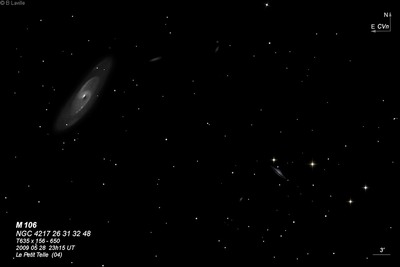
Pierre Méchain discovered M106 = NGC 4258 = H V-43 = h1175 in July 1781. It was discovered after Messier's final catalogue was sent to publication but was included in a letter dated 6 May 1783 to Johann Bernoulli, the editor of the Berliner Astronomisches Jahrbuch and published in the 1786 Jarbuch volume. Méchain wrote, "In July 1781, I have found another one close to Ursa Major near the star No. 3 of Canes Venatici & 1 deg more or less to the south; I estimate its right ascension 181d 40' & its declination about 49d."
William Herschel independently discovered this galaxy on 9 Mar 1788 and recorded H. V 43 as "v brilliant. BN with much fainter branches from np to sf, about 15' long, and the sf running out into vF nebulosity extending a great way." On 1 Apr 1788 (sweep 823) he logged "vB, mE directly in the meridian [N-S] with faint branches 10 or 12' long, BNM with the nucleus not ground."
John Herschel made 4 observations and recorded (sweep 330) "vB; vL; vsvmbM to an oval nucl; 8 or 9' long; 4 or 5' broad." The 20 Apr 1857 observation at Birr Castle (by R.J. Mitchell) reads "a vL, B, E neb np sf, much mottled. The f edge is comparatively sharp and well defined, but in the p and n edge there is a great inequality of light. Nucleus elongated, vB part to north of nucleus."
200/250mm - 8" bright, very large, elongated, bright core.
300/350mm - 13.1" (4/12/86): bright, very large, bright core, substellar nucleus, mottling near core. A large bright knot is at end of the southern arm.
13.1" (3/17/86): very bright, very large, impressive! Contains a nearly stellar core in a high surface brightness oval disk.
400/500mm - 17.5" (4/7/89): very bright, very large, very elongated 3:1 NNW-SSE, 14'x4', large bright core concentrated to a very small brighter central region. A thin bright spiral arm attached at the core extends towards the NNW on the following side of the galaxy. There is a sharp edge along the west side of this arm.
Notes by Steve Gottlieb